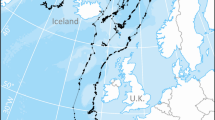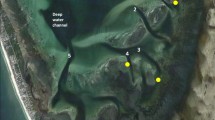Abstract
The Pechora Sea in the western Russian Arctic is inhabited by Atlantic walrus (Odobenus rosmarus rosmarus). Until recently, walruses in this region remained the least-studied stock within the Atlantic subspecies. This benthic feeding pinniped requires careful management in this area because of the rapid industrial development that has taken place in the last decade in the region. In this study, 35 adult male Atlantic walruses were tagged with platform terminal transmitters (PTTs) on the western coast of Vaygach Island in the Pechora Sea in July–August 2012–2017. For the 30 PTTs that functioned, the average duration of the tracking records was 47 ± SE 6 days (maximum: 155 days). Most of the tagged animals (83%) stayed in the eastern part of the Pechora Sea between Pechora Bay, the southern tip of Novaya Zemlya and the western coast of Vaygach Island. The identified core range (4000 km2) was located between Vaygach Island and Matveev and Dolgiy islands; including a series of coastal haul-outs and a marine area which is likely an important feeding ground. Five of the tagged walruses left the Pechora Sea and moved to areas up to 1500 km away (maximum 2115 km by track distance) from the tagging location, including the northern part of Novaya Zemlya, the central Kara Sea and the northern part of the Severnaya Zemlya Archipelago. This is the first evidence that walruses from the southeastern Barents Sea occupy the Kara Sea. Eight terrestrial haul-outs in the Kara Sea were identified.








Similar content being viewed by others
References
Andersen LW, Jacobsen MW, Lydersen C, Semenova VS, Boltunov AN, Born EW, Wiig Ø, Kovacs KM (2017) Walruses (Odobenus rosmarus rosmarus) in the Pechora Sea in the context of contemporary population structure of Northeast Atlantic walruses. Biol J Linn Soc 122(4):897–915
Andrianov VV (2004) Structure of walrus (Odobenus rosmarus rosmarus) aggregations on ice in the southeastern Barents Sea. Marine mammals of the Holarctic, collection of scientific papers after the 3rd international conference, 11–17 Oct 2004. Koktebel, Ukraine, pp 27–28
Boltunov AN, Belikov SE, Gorbunov YA, Menis DT, Semenova VS (2010) The Atlantic walrus in the southeastern Barents Sea and adjacent areas: review of present-day status. WWF-Russia and Marine Mammal Council, Moscow
Boltunov AN, Belikov SE, Nikiforov VV, Semenova VS, Stishov MS, Pukhova MA (2015) Aerial survey of the Pechora Sea and the area of Vaygach island in spring 2014. Marine mammals of the Holarctic, collection of scientific paper after the 8th International conference, 22–27 sept 2014. Saint-Petersburg, Russia, pp 72–73
Born EW, Knutsen LØ (1992) Satellite-linked radio tracking of Atlantic walruses (Odobenus rosmarus rosmarus) in northeastern Greenland, 1989–1991. Z Säugetierk 57:275–287
Born EW, Gjertz I, Reeves RR (1995) Population assessment of Atlantic walrus (Odobenus rosmarus rosmarus). Nor Polarinst Medd 138:1–100
Born EW, Acquarone M, Knutsen LO, Toudal L (2005) Homing behavior in an Atlantic walrus (Odobenus rosmarus rosmarus). Aquat Mamm 31:23–33
Born EW, Stefansson E, Mikkelsen B, Laidre KL, Andersen LW, Rigét FF, Villum JM, Bloch D (2014) A note on a walrus ́s European odyssey. NAMMCO Sci Publ 9:75–91
Chapskiy KK (1936) The walrus of the Kara Sea. Proceedings of the Arctic Institute, Leningrad (In Russian)
Chernook V, Solovyov B, Vasiliev A, Solodov A, Zemlyanskaya Y (2015) Results of aerial surveys of marine mammals in the offshore strips of the Kara Sea in August 2013. Marine Mammals of the Holarctic, collection of scientific papers after the 8th International conference, 22–27 sept 2014. St. Petersburg, Russia, pp 292–298
Chitta JJ, Quakenbush LT, Taras BD (2014) Estimation of calf:cow ratios of Pacific walruses for use in population modeling and monitoring. Mar Mamm Sci 30:20–43
Dietz R, Born EW, Stewart R, Heide-Jørgensen MP, Stern H, Rigét F, Toudal L, Lanthier C, Jensen MV, Teilmann J (2014) Movements of walruses (Odobenus rosmarus) between Central West Greenland and Southeast Baffin Island, 2005–2008. NAMMCO Scientific Publications 9:53–73
Dobrinskiy LN (1995) Nature of Yamal. Nauka, Ekaterinburg (In Russian)
Freitas C, Lydersen C, Fedak MA, Kovacs KM (2008) A simple new algorithm to filter marine mammal Argos locations. Mar Mamm Sci 24:315–325
Freitas C, Kovacs KM, Ims RA, Fedak MA, Lydersen C (2009) Deep into the ice: over-wintering and habitat selection in male Atlantic walruses. Mar Ecol Prog Ser 375:247–261
Gavrilo M (2010) On the modern distribution of Atlantic walrus (Odobenus rosmarus rosmarus) in the northern Kara-Barents Sea region. Marine mammals of the Holarctic, collection of scientific paper after the 6th International conference, 11–15 oct 2010. Kaliningrad, Russia, pp 125–129
Goryaev YI, Ezhov A, Vorontsov AV (2006) Vessel based observation of Atlantic walruses (Odobenus rosmarus rosmarus L.) in the southeastern part of Barents Sea. In: Marine mammals of the Holarctic, collection of scientific paper after the 4th International conference, 10-14 sept 2006, Saint-Petersburg, Russia, pp 145–146
Haug T, Nilssen KT (1995) Observations of walrus (Odobenus rosmarus rosmarus) in the southeastern Barents and Pechora seas in February 1993. Polar Res 14(1):83–86
Heide-Jørgensen MP, Flora J, Andersen AO, Stewart REA, Nielsen NH, Hansen RG (2017) Walrus movements in Smith Sound: a Canada-Greenland shared stock. Arctic 70(3):308–318
Jay CV, Heide-Jørgensen M, Fischbach AS, Jensen MV, Tessler DF, Jensen AV (2006) Comparison of remotely deployed satellite radio transmitters on walruses. Mar Mamm Sci 22(1):226–236
Laidre KL, Stern H, Kovacs KM, Lowry L, Moore SE, Regehr EV, Ferguson SH, Wiig Ø, Boveng P, Angliss RP, Born EW, Litovka D, Quakenbush L, Lydersen C, Vongraven D, Ugarte F (2015) Arctic marine mammal population status, sea ice habitat loss, and conservation recommendations for the 21st century. Conserv Biol 29(3):724–737
Lukin LR (1978) About terms and areas of the Atlantic walrus calving. Ekologiya 5:100–101 (In Russian)
Lydersen C, Kovacs KM (2014) Walrus Odobenus rosmarus research in Svalbard, Norway, 2000–2010. NAMMCO Sci Publ 9:175–190
Lydersen C, Aars J, Kovacs K (2008) Estimating the number of walruses in Svalbard from aerial surveys and behavioral data from satellite telemetry. Arctic 61:119–128
Lydersen C, Chernook VI, Glazov DM, Trukhanova IS, Kovacs KM (2012) Aerial survey of Atlantic walruses (Odobenus rosmarus rosmarus) in the Pechora Sea, August 2011. Polar Biol 35:1555–1562
Selin VS (2016) Driving forces and development problems of cargo flows along the Northern Sea Route. Arctic and North 22:87–100 (in Russian)
Semenova VS, Boltunov AN, Nikiforov VV, Svetochev VN (2012) Study of the Atlantic walrus (Odobenus rosmarus rosmarus) in the southeastern Barents Sea, 2011–2012. Marine mammals of the Holarctic, collection of scientific paper after the 7th International conference, September 24–28, 2012. Suzdal, Russia, pp 228–234
Semenova VS, Boltunov AN, Nikiforov VV (2015) Study and conservation of the Atlantic walrus in the southeastern Barents Sea and adjacent areas of the Kara Sea. The results of studies 2011–2014. WWF, Murmansk
Shitova MV, Boltunov AN, Nikiforov VV, Semenova VS, Babushkin MV, Malinina TV (2015) DNA variability in Atlantic walruses (Odobenus rosmarus rosmarus) from Vaygach Island. Marine mammals of the Holarctic, collection of scientific paper after the 8th International conference, 22–27 sept 2014. Saint-Petersburg, Russia, pp 327–334
Stewart REA (2008) Redefining Walrus stocks in Canada. Arctic 61:292–308
Stewart REA, Kovacs KM, Acquarone M (2014) Walrus of the North Atlantic. NAMMCO Scient Publ 9:7–12
Svetochev VN, Svetocheva ON (2008) Distribution of Atlantic walruses (Odobenus rosmarus rosmarus L.) in the White, Barents and Kara seas in 2004-2007. Marine mammals of the Holarctic, collection of scientific paper after the 8th International conference, 14-18 oct 2008, Odessa, Ukraine, pp 543–544
Urvantsev NN (1935) Two years in the Severnaya Zemlya archipelago. Glavsevmorput’, Leningrad (In Russian)
Vekhov N, Hakhin G (1999) How many walruses on Novaya Zemlya. Hunt Hunt Econ 4:14–15 (In Russian)
Wiig Ø, Gjertz I, Griffiths D (1996) Migration of walrus (Odobenus rosmarus) in the Svalbard and Franz Josef Land area. J Zool 238:769–784
Zaykin DA (2017) Comprehensive simulation model of marine transport and support system for “Prirazlomnaya” platform. Arctic 3(27):86–102 (in Russian)
Zyryanov SV, Vorontsov AV (1999) Observation of Atlantic walruses, Odobenus rosmarus rosmarus in the southeastern Barents Sea and in the Kara Sea in spring 1997. Rus J Zool 78:1254–1256 (In Russian)
Acknowledgements
A number of Companies operating in the Pechora Sea, as well as the Norwegian Polar Institute and WWF Russia financed different components of the field programme. The Norwegian-Russian Environmental Commission facilitated the study of walruses in the Barents Sea. The authors thank Miroslav Babushkin, Vladislav Svetochev and Vladimir Kipriyanov for considerable contributions to the field programme, and the residents of the Varnek settlement, particularly Mikhail Vylko for the help on fulfilling field studies on Vaygach Island. The authors are grateful to the staff of Nenetskiy State Nature Reserve and Kartesh RV for logistical help and to Ltd Es-Pas company for their open-minded approach to the development of the transmitters used in this stidy. Critical remarks and valuable advice of the Guest Editor of the Special Issue Alexey Sukhotin, reviewers Prof. Kit Kovacs, Prof. Mads Peter Heide-Jørgensen and Senior scientist Erik W. Born are gratefully acknowledged.
Author information
Authors and Affiliations
Corresponding author
Additional information
Publisher's Note
Springer Nature remains neutral with regard to jurisdictional claims in published maps and institutional affiliations.
This article belongs to the special issue on the "Ecology of the Pechora Sea", coordinated by Alexey A. Sukhotin.
Rights and permissions
About this article
Cite this article
Semenova, V., Boltunov, A. & Nikiforov, V. Key habitats and movement patterns of Pechora Sea walruses studied using satellite telemetry. Polar Biol 42, 1763–1774 (2019). https://doi.org/10.1007/s00300-018-02451-7
Received:
Revised:
Accepted:
Published:
Issue Date:
DOI: https://doi.org/10.1007/s00300-018-02451-7




